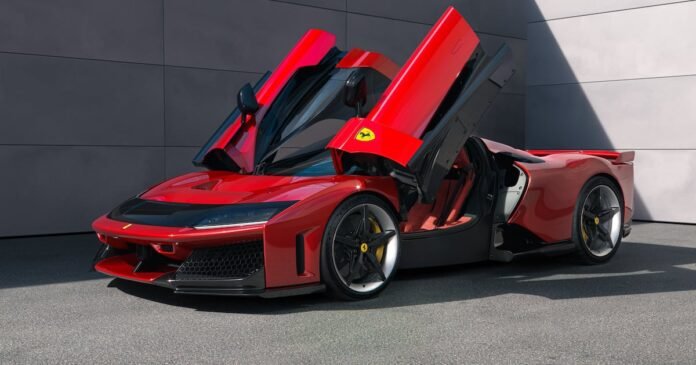Ferrari represents the pinnacle of performance, desirability and racing pedigree in the motoring world.
In its 86-year history, the Italian firm has created some of the world’s most expensive and fastest road cars.
Its latest creation, the F80, is the flagship of the Ferrari model line-up, featuring a 3.0-litre twin-turbocharged V6 and three electric motors to deliver 1,184bhp.
But which Ferrari supercars came before it? We’ve been looking at all of the classic models that the F80 will be looking up to.
288 GTO

The 288 GTO was one of the world’s first supercars when it was released in 1984.
It was powered by a 2.9-litre twin-turbocharged V8, with power sent to the rear wheels via a six-speed manual gearbox.
When it comes to numbers, the powertrain produced 389bhp and all the panels were made from carbon fibre, fibreglass and Kevlar, with the car weighing just 1,158kg.
The exterior featured flip-up headlights, quad daytime running lights and the air vents and spoilers paid homage to the old 250 GTO racer from the 1960s.
F40

One of Ferrari’s greatest hits arrived in 1987 with the F40, which took road cars to a new level.
The F40 was all about lightness, which meant that the interior was stripped out with no carpets or stereo and even the paint was a lot thinner than standard Ferraris – all to reduce the car’s weight.
Under the bonnet, it was powered by the same 2.9-litre twin-turbocharged V8 found in the 288 GTO, however, its displacement had been expanded, so power figures increased to 464bhp, with the car weighing just 1,254kg.
All of this weight-saving meant that the F40 at the time was one of the world’s fastest road cars with a 0-60mph time of 3.9 seconds and a top speed of 201mph – the first road car to break the 200mph barrier.
F50

The F40’s replacement was the F50, and it had big boots to fill after the success of its predecessor.
The F50 came fitted with a 4.7-litre naturally-aspirated V12 engine, producing 505bhp and it was accompanied by a top speed of 194mph.
The design changed too, with the car featuring exposed front headlights and deep channels to help flow air smoothly over the car and keep the V12 motor cool.
The car’s engine was mounted between the cabin and rear axle, making it mid-engined, which also helped to improve the car’s weight distribution.
Enzo (F60)

At the start of the new millennium, Ferrari decided to release a new supercar for the 21st century, and that was the F60 – also known as the Enzo.
It replaced the F50, and featured a slipperier body, scissor doors and a bigger 6.0-litre naturally-aspirated V12 powertrain that produced a total of 642bhp. All this power meant it could hit a claimed top speed of 217mph.
Other changes included carbon-ceramic brake discs, a carbon fibre body shell and a sharper Formula One-styled front end – cutting-edge technology for the time.
It also featured a semi-automated paddle-shift gearbox for faster shifts. Ferrari claims that just 400 examples of the Enzo were made worldwide.
La Ferrari

Before we had the F80, Ferrari gave us the La Ferrari, which may sound like a peculiar name – especially translated in Italian – meaning ‘The Ferrari’.
It formed part of the 2010s ‘Holy Trinity’ hypercar showdown, competing with direct rivals from Porsche and McLaren.
The La Ferrari was the first model in the firm to use a hybrid powertrain, which featured a 6.3-litre V12 mated to an electric motor, pumping out a colossal 937bhp and running all the way to a claimed top speed of 231mph.
Also, the La Ferrari featured a seven-speed dual-clutch paddle-shift gearbox, with power being sent to the rear wheels.
Plus, there was even a drop-top ‘Aperta’ model, which featured a carbon fibre lid and canvas cover, to give the ultimate wind-in-the-hair experience.








